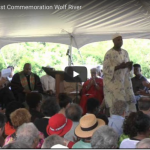In Memphis, Tennessee, more than 500 people came together in May 2017 to mark the centennial of the death of Ell Persons. The Black woodcutter was lynched alongside the Wolf River a century earlier after being blamed for the death of a 16-year-old White girl named Antoinette Rappel. John Ashworth is executive director of the Lynching Sites Project of Memphis, the community group that organized Persons’ memorial. Ashworth says he has been involved in seven or eight soil ceremonies like this one, resulting in jars of earth sent to join the others in Montgomery, as if filled with remains.
After scooping soil from the banks of the Wolf River, community members, including descendants of Persons and Rappel, gathered around the pile of earth. “We try to allow for every person participating to come up and put a pinch of soil in [the jar] so they, in fact, have a part in the ceremony,” he says. “That in and of itself brings about a certain amount of feeling or connection.” It also aids in communication, in changing the narrative, Ashworth says.
“We did it in Alamo, we did it in Brownsville, we’ve done it a couple times in Memphis … it’s a very cathartic process.” Ashworth says using soil has made the work of interpersonal and historical reconciliation a little bit easier, and in the process given rise to “a renewed sense of each other’s humanity.”








































